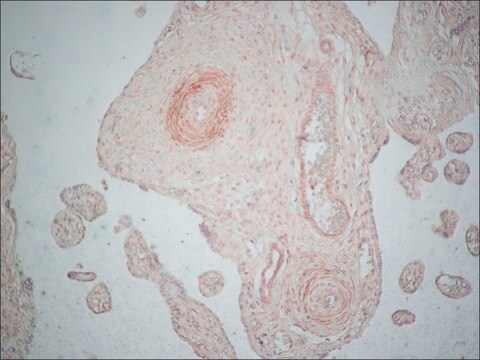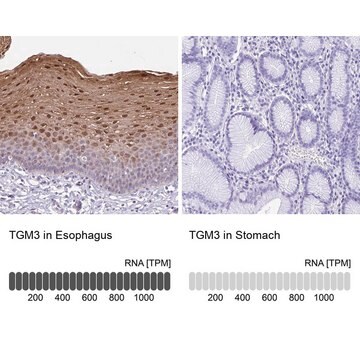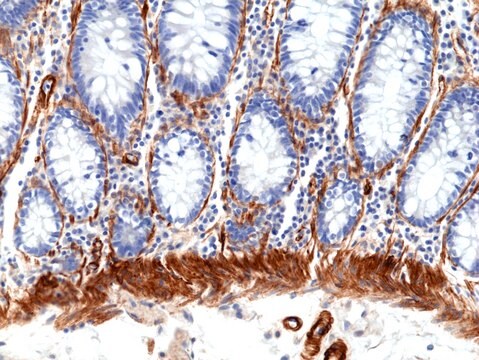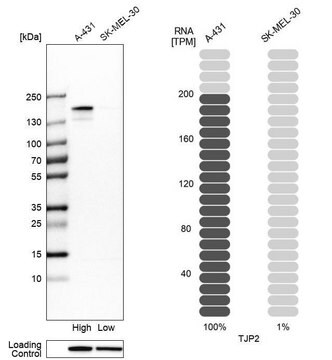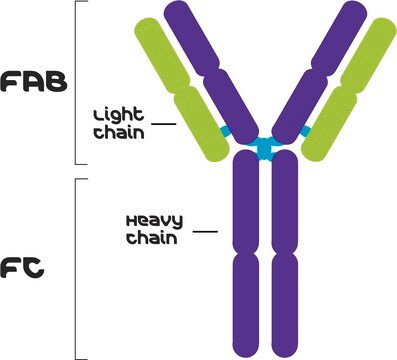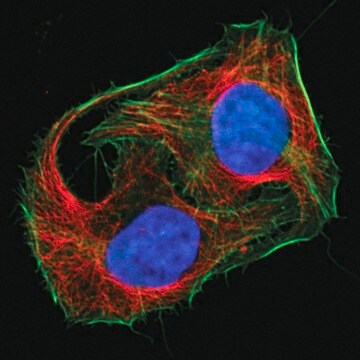일반 설명
We are committed to bringing you greener alternative products, which adhere to one or more of The 12 Principles of Green Chemistry.This antibody is Preservative-free, produced without the harm or sacrifice of animals and exceptionally stable to allow for ambient shipping and storage if needed and thus aligns with "Waste Prevention", "Designing Safer Chemicals" and "Design for Energy Efficiency".
Click here for more information.
ZooMAb® antibodies represent an entirely new generation of recombinant monoclonal antibodies.Each ZooMAb® antibody is manufactured using our proprietary recombinant expression system, purified to homogeneity, and precisely dispensed to produce robust and highly reproducible lot-to-lot consistency. Only top-performing clones are released for use by researchers. Each antibody is validated for high specificity and affinity across multiple applications, including its most commonly used application. ZooMAb® antibodies are reliably available and ready to ship when you need them.
특이성
Clone 1E8 is a ZooMAb® Rabbit recombinant monoclonal antibody that specifically detects Caldesmon. It targets an epitope within 23 amino acids from the C-terminal region.
면역원
KLH-conjugated linear peptide corresponding to 23 amino acids from the C-terminal region of human Caldesmon.
애플리케이션
Quality Control Testing
Evaluated by Western Blotting in HT1080 cell lysate.
Western Blotting Analysis: A 1:1,000 dilution of this antibody detected Caldesmon in HT1080 cell lysate.
Tested Applications
Immunocytochemistry Analysis: A 1:100 dilution from a representative lot detected Caldesmon in C6 cells.
Affinity Binding Assay: A representative lot of this antibody bound Caldesmon peptide with a KD of 1.0 x 10-12 in an affinity binding assay.
Immunohistochemistry (Paraffin) Analysis: A 1:100 dilution from a representative lot detected Caldesmon in human uterus tissue sections.
Flow Cytometry Analysis: 0.1 μg from a representative lot detected Caldesmon in one million C6 cells.
Note: Actual optimal working dilutions must be determined by end user as specimens, and experimental conditions may vary with the end user.
표적 설명
Caldesmon (UniProt: Q05682; also known as CDM) is encoded by the CALD1 (also known as CAD, CDM) gene (Gene ID: 800) in human. Caldesmon is an actin- and myosin-binding protein that is implicated in the regulation of actomyosin interactions in smooth muscle and non-muscle cells. It stimulates actin binding of tropomyosin that increases the stabilization of actin filament structure. In muscle tissues, it inhibits the actomyosin ATPase by binding to F-actin. This inhibition is reduced by calcium-calmodulin and is potentiated by tropomyosin. It is detected on thin filaments in smooth muscle and on stress fibers in fibroblasts. Its expression is not observed in skeletal muscle or heart. Six different isoforms of caldesmon have been described that are produced by alternative splicing. High molecular weight caldesmon (isoform 1) is expressed in smooth muscle, whereas low molecular weight forms are distributed in non-muscle tissue and cells. Its N-terminal domain has a myosin/calmodulin-binding domain, and the C-terminal region contains a tropomyosin/actin/calmodulin-binding domain. These two domains are separated by a central helical region in smooth muscle isoform. In non-muscle cells, phosphorylation by CDK1 during mitosis causes caldesmon to dissociate from microfilaments. Phosphorylation reduces caldesmon binding to actin, myosin, and calmodulin and inhibits actomyosin ATPase activity. The upregulation of caldesmon is reported in several solid tumors and it is considered as a reliable biomarker for pathological diagnosis and prediction of chemotherapy response. Caldesmon can also suppress cancer metastasis by regulating the podosome/invadopodium formation in transformed cancer cells. This ZooMAb® recombinant monoclonal antibody, generated by our propriety technology, offers significantly enhanced specificity, affinity, reproducibility, and stability over conventional monoclonals. (Ref.: Yao, YB., et al (2021). Front. Cell Dev. Biol. 9; 634759; Lee, MS., et al. (2015). Oncotarget. 6(37); 40370-40384; Huber, PA., et al. (1993). J. Muscle Res. Cell Motil. 14(4); 385-391).
물리적 형태
Purified recombinant rabbit monoclonal antibody IgG, lyophilized in PBS, 5% Trehalose, normal appearance a coarse or translucent resin. The PBS/trehalose components in the ZooMAb formulation can have the appearance of a semi-solid (bead like gel) after lyophilization. This is a normal phenomenon. Please follow the recommended reconstitution procedure in the data sheet to dissolve the semi-solid, bead-like, gel-appearing material. The resulting antibody solution is completely stable and functional as proven by full functional testing. Contains no biocide or preservatives, such as azide, or any animal by-products. Larger pack sizes provided as multiples of 25 μL.
재구성
30 μg/mL after reconstitution at 25 μL per vial. Please refer to guidance on suggested starting dilutions and/or titers per application and sample type.
저장 및 안정성
Recommend storage of lyophilized product at 2-8°C; Before reconstitution, micro-centrifuge vials briefly to spin down material to bottom of the vial; Reconstitute each vial by adding 25 μL of filtered lab grade water or PBS; Reconstituted antibodies can be stored at 2-8°C, or -20°C for long term storage. Avoid repeated freeze-thaws.
법적 정보
ZooMAb is a registered trademark of Merck KGaA, Darmstadt, Germany
면책조항
Unless otherwise stated in our catalog or other company documentation accompanying the product(s), our products are intended for research use only and are not to be used for any other purpose, which includes but is not limited to, unauthorized commercial uses, in vitro diagnostic uses, ex vivo or in vivo therapeutic uses or any type of consumption or application to humans or animals.




